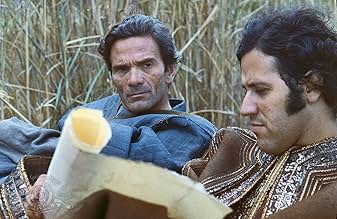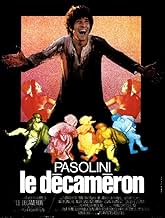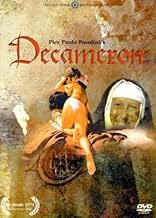Une adaptation de neuf histoires du « Décaméron » de Boccace.Une adaptation de neuf histoires du « Décaméron » de Boccace.Une adaptation de neuf histoires du « Décaméron » de Boccace.
- Prix
- 1 victoire et 3 nominations au total
Jovan Jovanovic
- Rustico
- (scenes deleted)
Maria Gabriella Maione
- Una madonna
- (as Gabriella Frankel)
Pier Paolo Pasolini
- Allievo di Giotto
- (as P.P. Pasolini)
Histoire
Le saviez-vous
- AnecdotesIl Decameron (1971) is the first film in Pier Paolo Pasolini's "Trilogy of Life," continuing with I racconti di Canterbury (1972) and concluding with Il fiore delle mille e una notte (1974). Each film was an adaptation of a different piece of classical literature focusing on ribald and often irreligious themes. The tales contain abundant nudity, sex, slapstick and scatological humor.
- GaffesWhen the Mother Superior seduces the deaf-mute boy, he's sleeping in a tomato garden. Tomatoes are a New World crop that wouldn't be brought to Italy for another two centuries. The same is true of the corn (maize) growing in the convent's little field.
- Citations
Allievo di Giotto: Why create a work of art when dreaming about it is so much sweeter?
- Autres versionsAlthough the cinema version was intact the 1988 UK Warner video was cut by 22 secs by the BBFC to remove shots of naked genitals during the bedroom sex scene with the nun. The cuts were fully restored in the 2001 BFI DVD release.
- ConnexionsEdited into Porno & libertà (2016)
- Bandes originalesFenesta Ca Lucive
Written by Guglielmo Cottrau, Vincenzo Bellini and Giulio Genoino in 1842
Performed by Franco Citti
Sung by Ser Ciappelletto and his Neapolitan hosts in Germany. Also sung by one of the Neapolitans to a monk.
Commentaire en vedette
The first of what became Pier Poalo Pasolini's Trilogy of Life, with each film adapting stories from archaic literature. In this case, Giovanni Boccaccio's book of the same name, written in 14th century Italy. The film takes nine of the 100 stories from the book and weaves them into vignettes of everyday Medieval life. We see nymphomaniac nuns, grave robbing, deceit, and cuckolding. In one segment, a boy is lured into the house of a pretty girl. She tells him that he is her brother. however, after taking his clothes and money, the boy is thrown out, where he is picked up by a couple of thieves who recruit him to climb inside of a tomb and steal the recently dead archbishop's ruby ring. The boy is left trapped in the grave.
This bawdy romp is a lot of fun. This was a surprise being Pasolini. The portmanteau style storytelling works well with this roaming tour through a debauched, ancient landscape. Many of the oddball characters were non- actors (something Pasolini had used throughout his career), and some have such incredibly rickety teeth, and are a strange and uncomfortable, yet thoroughly enjoyable watch.
The film ends with a statement by Pasolini himself (he played the painter, Giotto between, and within some of the stories), which is possibly a statement about the dream like quality the narrative has in its assemblage of the parts. He says: Why create a work of art, when you can just dream about it? Indeed, why create narrative cinema, when you can manoeuvre through scenes of life and create a patchwork of living, permeated with verisimilitude.
www.the-wrath-of-blog.blogspot.com
This bawdy romp is a lot of fun. This was a surprise being Pasolini. The portmanteau style storytelling works well with this roaming tour through a debauched, ancient landscape. Many of the oddball characters were non- actors (something Pasolini had used throughout his career), and some have such incredibly rickety teeth, and are a strange and uncomfortable, yet thoroughly enjoyable watch.
The film ends with a statement by Pasolini himself (he played the painter, Giotto between, and within some of the stories), which is possibly a statement about the dream like quality the narrative has in its assemblage of the parts. He says: Why create a work of art, when you can just dream about it? Indeed, why create narrative cinema, when you can manoeuvre through scenes of life and create a patchwork of living, permeated with verisimilitude.
www.the-wrath-of-blog.blogspot.com
- tomgillespie2002
- 8 janv. 2012
- Lien permanent
Meilleurs choix
Connectez-vous pour évaluer et surveiller les recommandations personnalisées
- How long is The Decameron?Propulsé par Alexa
Détails
- Date de sortie
- Pays d’origine
- Langues
- Aussi connu sous le nom de
- The Decameron
- Lieux de tournage
- sociétés de production
- Consultez plus de crédits d'entreprise sur IMDbPro
Box-office
- Brut – à l'échelle mondiale
- 839 $ US
- Durée1 heure 51 minutes
- Mixage
- Rapport de forme
- 1.85 : 1
Contribuer à cette page
Suggérer une modification ou ajouter du contenu manquant

Lacune principale
By what name was Il Decameron (1971) officially released in Canada in French?
Répondre



























